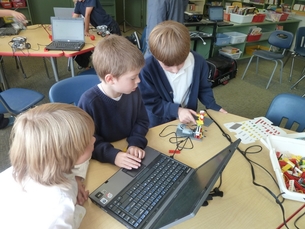
Our goal is to ensure every student has access to and engages in learning opportunities according to her/his individual strengths and abilities. In doing so, students demonstrate their learning in a variety of ways. So, what does that all mean in practice? UDL offers students more ways to access the curriculum through multiple means of representation, more ways with participate or engage in learning through multiple means of engagement, and finally more ways to demonstrate their learning through multiple means of expression.
Simply put, Multiple means of Representation give all students different ways to access a topic, concept or skill. At our school that might mean using assistive technology (like "Read and Write for Google"); or presenting concepts through graphic organizers or hands-on manipulatives; or Smart Board demos; or video links. The key is to use multiple pathways concurrently to ensure that everyone has access in their preferred method and also receives reinforcement through another route to learning.
Multiple Means of Engagement are all about the "hook". What approaches will open up the learning experience for each student? Are they more likely to get excited about a topic or concept with a hands-on introduction? Or a video? Or a SmartBoard simulation? Do they feel more comfortable working in the lab or from a textbook or on-line source? Would they prefer to solve a math problem by manipulating number tiles, sketching it out, or solving it in a linear fashion on paper? Does cooperative learning work for them or would they rather puzzle it out on their own. The answer, for any classroom of kids, is "all of the above". Consequently, the more approaches to learning that you can offer a group of children, the more likely it is that you will make the material accessible to everyone.
Finally, after you have taught a concept in multiple ways, and offered students a chance to engage in their own learning through a range of pathways, the final step is to offer Multiple Means of Expression for them to demonstrate their understanding. Let me give you an example. One of our teachers was facilitating an inquiry approach to learning about different aspects of ancient Egyptian civilization. They used multiple means of engagement in their learning process and now it was time to demonstrate what they had learned. He staged a "what's worth knowing" fair in his classroom and gave his students carte blanche to select ways in which to highlight what they found to be most important about their area of inquiry. The result was a wide range of modalities of presentation. There were clay models of boats; an Egyptian "make-up salon" where you could get your eyes done; sketchbooks; poster-board displays; a couple of videos; and even a Minecraft reconstruction of the interior of a pyramid. Every student found her or his preferred method of sharing their findings with their classmates, teachers and parents. It was "universal" in its scope.
You see, school doesn't need to be the same for everyone in order to be equal for all. In fact, just the opposite. A one size fits all approach will always favour some but a universal design approach is a way effectively differentiate the learning experience and is a key component of inclusion.
In the third (and final!) part of this discussion, we will look at how universal design is applied to not only classroom instruction, but to the learning environment as a whole.


 RSS Feed
RSS Feed
